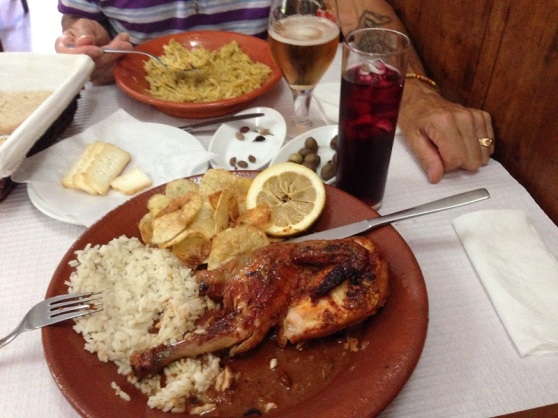
Elvas is one of Portugal’s many charming villages that in a previous existence were strategic, fortified frontier posts. Small and snuggled close to the Spanish border, they have a somewhat terrifying history, but now allow the traveller a fascinating insight into Portugal’s struggle to maintain its existence. Here, especially in these small, rural towns we can also enjoy its ancient architecture, traditional culture and cuisine.
Elvas is in the Alentejo region and the town is dominated by its small but highly fortified castle. From up on its battlements you have amazing views that stretch out over the northern fortification of Forte de Graça and east over the rolling plains into Spain. Our experience of this expansive view – on one particularly sultry summer’s evening – had us entranced; Spain’s Extremadura was burning up with a series of bush fires and the whole eastern sky was aglow with a russet-pink hue.
Positioned on the highest point of the city, the Castelo de Elvas is possibly Portugal’s most battle-hardened castle, having survived numerous sieges and battles over its long and turbulent history. Constructed purely for defence, it has thick solid walls, high battlements and a solid keep. Its panoramic view over the surrounding landscape and deep into the Spanish heartland speaks volumes of its historic role.

Portugese Potter and Poet
An open door that gave access into one of the old castle’s towers beckoned, and it was here we found Luis standing outside chatting with some friends. We were curious as to what was within, secretly harbouring thoughts of encountering ancient relics from the castle’s past. But when we sought entrance into the old tower he told us it was his workshop. Clearly, we were a wee bit late for discovering ‘antiquities’. Introductions over, he explained that he was finishing up for the day but would give us a quick look around. Following that, he offered to show us his finished wares in his nearby studio-gallery.
The body of work of this talented ceramic artist is notable in that it is both eclectic and prodigious, and while his design-style is unique, it evinces Portugal’s distinctive ceramic tradition. He is also a poet of some note and a discerning collector of ethnic art; this makes a visit to his studio-gallery an interesting experience.
Besides his more interesting works of art, however, his stock and favoured item is the folksy, traditional Ronca. This musical instrument has a long association with Portugal’s past yet, interestingly, and perhaps like wine, it has travelled far. Originating in Africa to accompany sacred and secret rituals, it was also found in Cuba. And in Venezuela it is called a Furruco, in Spain a Zambomba, in southern Italy a Putipù, in Germany a Rummelpot and so on – very well-travelled. Luis actively markets and demonstrates this instrument and many a visitor to Elvas now has a Ronca on their shelf at home. Though it is a mono-tone instrument, its sound will immediately evoke in the tourist’s memory Luis Pedras, the Castelo de Elvas and this quaint little town.
Given the diverse and ancient roots of the Ronca and Luis’ interest in distant peoples and cultures, one can appreciate his abiding interest in this membranophone instrument. He, too, has travelled widely and has a fascinating collection of artefacts from exotic lands. Though they are not for sale, many can be found in his studio workshop.
We both admire ceramic artistry and have a substantial pottery collection of our own. However, like so many other travellers who are on a tight budget and who prefer to travel light, we often have to decline artists’ and artisans’ beautiful works. Luis, bless his cotton socks, in spite of our expressing this, was not at all deterred by our protestations – we ended up buying a (very transportable – and signed) little book of his poems in Spanish and Portuguese.
Do not underestimate the small town of Elvas; there is excellent local cuisine to be had, and superb Alentejo wine to accompany it. Do not leave without tasting some Ameixas d´Elvas either (just ask 😉 ). There is also much antiquity to be explored and it is surprisingly photogenic.




































